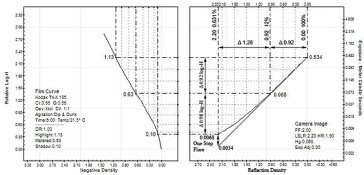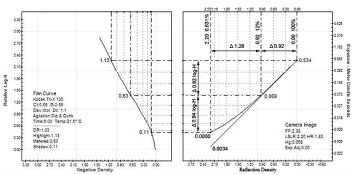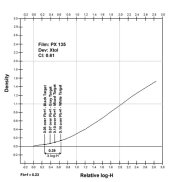I developed one of the five rolls tonight (for 11mins). Before I develop the other ones I'm a bit concerned about two things
1. I used a 31 step Tx wedge. I did one development for 11mins and steps 24 through 31 (Tx densities 2.35 to 3.05) are all at the density of the film base+fog. ....
2. I use XTOL 1+2 dilution which results in longer dev times. What set of dev times should I use instead of the the nominal ones you list (spanning 4-16min)?
I think I can answer my questions. I looked at the example numbers in the spreadsheet and I was surprised to find the lowest two dev times (4 and 5.5 mins) both had very similar Tx densities (of about 0.05) for steps 24-31.
With increasing dev time, (esp up at 16mins in the example excel spreadsheet) those steps do increase marginally in density on the negs. So I think I will just need to extend my dev times out to perhaps 25 minutes.
I forgot that increasing the dev time does have a minor effect on the shadow density but primarily it is the exposure times which lock in the shadow density. Therefore I haven't wasted those steps on my Tx wedge, as most of them will play a part at higher dev times.
So now to estimate my remaining dev times.
From the example excel spreadsheet I fitted the points (1,4),(2,5.5),(3,8),(4,11),(5,16)=(n,t) to the general exponential curve t = m x EXP (a x n) :
t = 2.7968 x EXP(0.3466 x n)
with R² = 0.9992
I then fixed a, passed it through my own point (2,11min) and solved for a new m, giving me
t = 5.5 x EXP (0.3466 x n)
I then fixed a, passed it through my own point (2,11) and solved for a new m, giving me
t = 5.5 x EXP (0.3466 x n)
This gives me new points of (1,7.8),(2,11),(3,15.6),(4,22),(5,31.1)=(n,t)
The nominal dev time
here for my choice of film, dilution, temp(20degC) and EI (200) is about 13mins.
I think my proposed dev times seem too long. So I'll recalculate this exponential equation with a two point fit to solve for both m and a after I do the next dev at say about 20mins.














